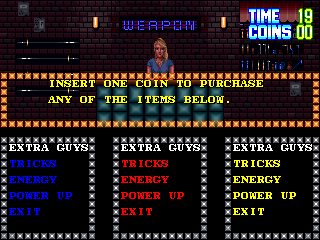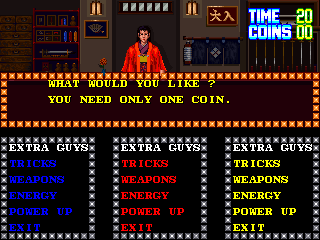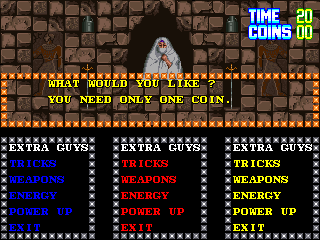Double Dragon 3: The Rosetta Stone (Arcade)
| Double Dragon 3: The Rosetta Stone |
|---|
|
Developer: East Technology
|
Double Dragon 3: The Rosetta Stone is Billy and Jimmy's third arcade outing, in which they are joined by their long-lost brother Sonny (wouldn't that make them the Triple Dragons then?).
It also continues the tradition of Technos properties innovating gaming, albeit in a controversial way: it introduces shops where players can gain access to characters, moves, and weapons... by putting even more quarters into the machine. Why yes, that does sound a hell of a lot like microtransactions years before they were a thing, and nearly all the bad parts of the practice at that. (Note that none of this applies to the Japanese version.)
| To do: There seem to be a few unused voice clips for the shopkeepers. |
Contents
Sub-Pages
| Development Info |
| Prerelease Info |
Exception Handler
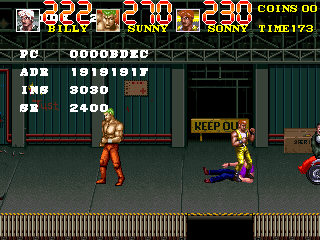
If the game ever crashes, it'll display this exception handler.
Unused Graphics
| Early (Mockup) | Final |
|---|---|
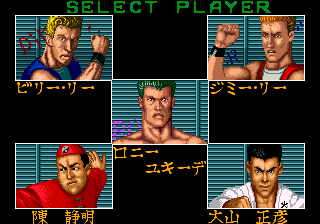 |
 |
Graphic tiles for an early version of the character select screen that was implemented in the later-released Japanese version can be found in the US version, revealing the original plans for the character roster.
As seen on the recreation on the left, the roster originally consisted of Billy and Jimmy Lee (top-left and top-right respectively), plus the three new fighters: Roney Urquidez (center), Chin Seimei (lower-left), and Masahiko Oyama (lower-right). In the final game, this idea evolved into four groups of palette-swapped siblings (Lee Brothers, Chin Brothers, Urquidez Brothers, Oyama Brothers) in order to allow multiple players to control the same character type. As a result, the fifth portrait, meant for Jimmy, went unused in the finalized character select screen since Billy's portrait is used to represent both Lee Brothers (plus Sonny, a third sibling who didn't exist in previous games, in 3-Player mode). Also, the karate fighter was renamed from Masahiko to Masao in the final game.
The unique "Select Player" banner on the top of the screen also went unused in favor of having the words spelled using a standard font set. The Japanese writings used to spell each character's full name are partially used (albeit loaded from a separate tileset) alongside a pair of Kyoudai (兄弟) tiles (the kanji characters for "brothers") that are loaded as sprite layers rather than as background tiles like the rest of the characters. If you look closely at the Japanese text for the Lee Brothers (リー兄弟), you can see half of the interpunct from back when the text originally spelled out Billy Lee (ビリー・リー).
There are tiles for early 1P and 2P cursors that are more detailed than the finalized versions. Inexplicably, the color-coding is reversed from the usual pattern of having Player 1 as blue and Player 2 as red (the palette data is shared for both unused cursors). There is no 3P cursor in this set, which seems to suggest that these were made before the decision to add 3-player support to the game.
| Name | Billy Lee | Jimmy Lee | Roney Urquidez | Chin Seimei | Oyama Masahiko |
|---|---|---|---|---|---|
| Description | Successor to Sousetsuken | Billy's older brother | World's Martial Arts Champion | Expert of Tai Chi | Instructor of Seishin Karate |
| Height | 175cm | 178cm | 197cm | 169cm | 174cm |
| Weight | 65kg | 70kg | 83kg | 84kg | 64kg |
| Special Technique | Head-to-Tail Dragon God Fist (One-Armed Head Butt) |
Flying Dragon Drop Spin | Solid Foot Dragon Tail Spin (Handstand Ankle Flip) |
Both Eye and Ear (Locking Head Squeeze) |
Tiger Rotating Mountain (Overhead Collar Throw) |
A set of information for the playable fighters, possibly intended for a demo sequence of sorts. It consists of the name of each character, a one-line description, their height and weight, and the name of their signature move (each written in kanji with furigana underneath). Most of this info can be seen on the Japanese version's instruction card and flyer, but since Billy and Jimmy were planned to be separate characters, their data, including signature moves, differs from each other here. The alternate names in parentheses for each move are the localized names that were used on the US version's cabinet.
| To do: Properly reconstruct the cut dojo building or see if there's a way to access it in the actual game. |

![]()
Billy and Jimmy's martial arts school, the Sou-Setsu-Ken Dojo, was planned to appear in Mission 1, as seen in a screenshot on the game's Japanese flyer. While the area was cut, the background tiles are still present in the data.
![]()
A "STONE" indicator that can be seen in screenshots on the game's flyers, possibly intended to show the number of Rosetta Stones that the player have collected. It was replaced in the final version by the timer, but the graphics for it were kept in the tiles for the HUD.
![]()
Various frames of one of the Rosetta Stones rotated at different angles. This set of tiles is stored among the graphics used for fonts and HUD. Only the second tile is used: in the second area of Mission 3, the Ashura statue in the background can be seen holding a stone until it disappears after the boss is defeated.
These unused graphics are specific to the Japanese version. Unlike the English version, which uses a font set to compose every message in the game, all the messages were written directly into the graphic tiles, likely in order to get around having to draw a whole new font set for a game with minimal dialogue. Almost everything is used, except for the following three messages:
Unused Music
| ID | Track | Notes |
|---|---|---|
| 001 | The attract mode music lasts for 1 minute and 47 seconds and then loops, but the game only allows about 1 minute and 12-28 seconds of the track to play before stopping the music once it has finished running the gameplay demos. (How long it plays depends on game version and player count due to performance issues in the US version, especially with 3 players, causing slowdown during the gameplay demos, thus allowing the music to play for a longer time compared to the Japanese version.) | |
| 017 | It is unknown where exactly this track was supposed to play, but it is located between the music used for Missions 5-3 and 5-4. A rendition of this track is played in Mission 5-3 of the NES version. |
Developer Credits
Present at 0x100 in the main CPU.
**************************************************************** * SYSTEM MAIN PROGRAM << SYSTEM.S >> * *Designed: N.takioka 1990-06-15 * *Coded : N.takioka 1990-06-15 * *Copyright(C) 1990 Technos Japan Corp. All rights reserved * ****************************************************************
Regional Differences
Gameplay
- The strength of enemy attacks is 50% greater in the US version (e.g. an attack that does 8 points of the damage in the Japanese version does 12 in the US version).
- Players begin each stage with temporary invincibility in the Japanese version. No such kindness is present in the US version.
- In the US version, the flying spiky disk on the third section of Mission 5 charges toward the players after side-hovering once. In the Japanese version, it charges the players after hovering 3 times.
- Additionally, either intentionally or due to an oversight, said disk's hitbox is way larger than its sprite in the US version and covers the entire upper portion of the screen! This results in the most unfair hits players can receive in the game: even if the disk flies to the bottom-left/right parts of the screen and the players are on the topmost parts, the players will still take a hit. In the Japanese version, the hitbox was reduced to the size of the disk's sprite.
Item Shops
The biggest difference between the US and Japanese versions is the presence of item shops in the former. The US version features an item shop at the start of the first three stages and another in the middle of Mission 5. In these shops, the player can obtain all sorts of powerups by using more credits. These item shops are inaccessible in the Japanese version, with the game being adjusted accordingly:
- The US version only allows the player to start the game as one of the Lee brothers (Billy, Jimmy, or Sonny). The other character types (the Urquidez, Chin, and Oyama brothers) must be unlocked by purchasing the "Extra Guys" option from the item shops and each one can only be obtained from a specific stage (for example, the reserved fighter the player will get from the first stage will be an Urquidez brother), meaning that not all the character types can be used until the third stage. The new character will then appear when the current one dies (up to three fighters can be stock-up in reserve), but the player will default back to the Lee brother character if they run out of reserve fighters and use a credit to continue. The Japanese version allows the player to start the game as any character type and even change to another one when continuing.
- The hurricane kick and jumping throw can only be performed in the US version by purchasing "Tricks" from the item shop. While these two techniques are transferred over from the player's current character to the next reserved fighter, the player will lose the ability to use them once all the reserved fighters have been lost, forcing the player to purchase them again to unlock these moves. In the Japanese version, both techniques are available by default but the input method for the hurricane kick was made trickier to pull off, requiring the player to push jump and then kick in very quick succession.
- Weapons can be purchased in the US version from Mission 2 onward while controlling a Lee brother, with the available options being a nunchaku in Mission 2 and a sword in Missions 3 and 5. In the Japanese version, weapons are instead found lying around in certain areas and the nunchaku can be obtained as early as the first area of Mission 1.
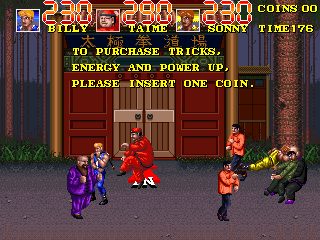
As a result of their removal in the Japanese version, the "IN" indicator goes unused and the shops in the stage backgrounds remained present but are no longer accessible, making them purely decorative. Additionally, the attract mode text (seen here) mentioning the shops was taken out and the gameplay demos were redone to exclude the item shops.
Stages
| US | Japan |
|---|---|
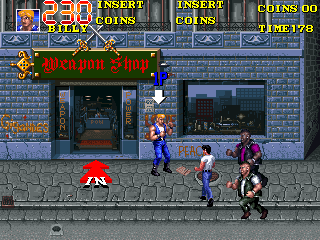 |
 |
In the US version, Mission 1 starts in front of the very first item shop. In the Japanese version, this portion of the area was cut and the starting point was moved to the front of the Power Records building that follows it, resulting in a smaller playing field.
| US | Japan |
|---|---|
 |
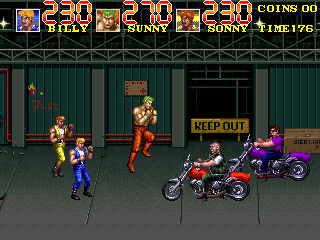 |
The character-moving conveyor belts and the deadly pitfall in the second area of Mission 1 are absent in the Japanese version, leaving an unusual blank space at the bottom of the area.
References
- Pages missing developer references
- Games developed by East Technology
- Games published by Tecmo
- Pages missing publisher references
- Games published by American Technos
- Arcade games
- Games released in 1990
- Games released in November
- Games with hidden developer credits
- Games with unused graphics
- Games with unused music
- Games with debugging functions
- Games with regional differences
- To do
- Double Dragon series
Cleanup > Pages missing developer references
Cleanup > Pages missing publisher references
Cleanup > To do
Games > Games by content > Games with debugging functions
Games > Games by content > Games with hidden developer credits
Games > Games by content > Games with regional differences
Games > Games by content > Games with unused graphics
Games > Games by content > Games with unused music
Games > Games by developer > Games developed by East Technology
Games > Games by platform > Arcade games
Games > Games by publisher > Games published by Koei Tecmo > Games published by Tecmo
Games > Games by publisher > Games published by Technos Japan > Games published by American Technos
Games > Games by release date > Games released in 1990
Games > Games by release date > Games released in November
Games > Games by series > Double Dragon series


